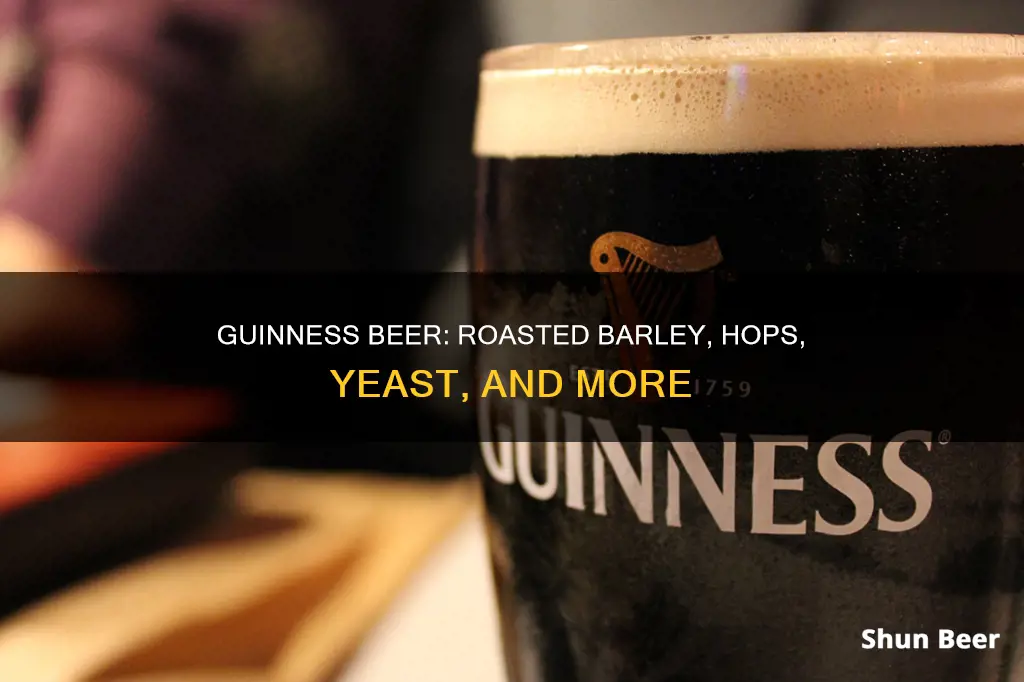
Guinness is a traditional Irish stout beer made from a combination of barley, hops, water, and a specific strain of ale yeast, now often called Guinness yeast. The beer gets its distinctive dark colour and caramelised flavour from barley that has been roasted but not malted. The creamy head of the stout is achieved by mixing the beer with nitrogen, which creates smaller bubbles and a thicker head. The draught beer is charged with a combination of carbon dioxide and nitrogen, giving it a smooth, velvety mouthfeel. The addition of nitrogen to beer was first pioneered by Guinness, and the brand has continued to innovate, recently releasing Guinness MicroDraught, which serves draught Guinness on tap without the need for a gas cylinder.
| Characteristics | Values |
|---|---|
| Main ingredients | Water, barley, roast malt extract, hops, brewer's yeast |
| Alcohol by volume (ABV) | 4.1% to 8% |
| Calories | 125 per pint |
| Colour | Dark shade of ruby |
| Head | Dense and creamy |
| Bubbles | Small |
| Temperature | 6-7 °C (42.8 °F) |
| Serving size | Pint |
| Glass type | Tulip-shaped pint glass |
| Pouring technique | Double pour |
What You'll Learn
- The ingredients: water, barley, hops, and yeast
- The filtration process: now vegan-friendly
- The export journey: how Guinness preserved its beer for overseas travel
- The perfect pour: the two-stage pour and the surge and settle effect
- The widget: a small, white nitrogen-filled ball that creates a smooth, velvety texture

The ingredients: water, barley, hops, and yeast
Guinness stout is made from water, barley, roast malt extract, hops, and brewer's yeast. Each ingredient is carefully selected and combined to create the distinctive flavour, colour, and texture that have made Guinness one of the most successful alcohol brands worldwide.
Water is a fundamental ingredient in beer brewing, and the quality and characteristics of the water used can significantly impact the final product. The water used in Guinness brewing is carefully sourced and treated to ensure it meets the specific requirements for brewing their iconic stout.
Barley is another key ingredient in Guinness, and it undergoes a special process to unlock its unique flavour contribution. A portion of the barley is malted, which involves steeping it in water to germinate, and then drying it to halt the germination process. This malted barley provides the sugars that will be fermented by the yeast to produce alcohol. Additionally, a portion of the barley is roasted, which gives Guinness its distinctive dark colour and contributes to its characteristic flavour.
Hops are added to the brew to provide bitterness and flavour. They also act as a natural preservative, helping to extend the shelf life of the beer. The specific variety and amount of hops used in Guinness's recipe are carefully guarded secrets, contributing to the unique character of their beer.
Finally, yeast is the ingredient that brings the brew to life. Brewer's yeast is added to the mixture of water, barley, and hops, initiating the fermentation process. The yeast feeds on the sugars extracted from the barley, producing alcohol and carbon dioxide as by-products. The specific strain of yeast used by Guinness is carefully selected and cultivated to ensure consistent flavour and quality in every batch of their stout.
The combination of these ingredients, along with Guinness's meticulous brewing processes and traditions, results in a rich, creamy, and balanced stout that has become a beloved beverage for many around the world.
Football Stars in Guinness Beer Ads: Who's Featured?
You may want to see also

The filtration process: now vegan-friendly
Guinness is now officially vegan-friendly, thanks to a new filtration process that was introduced in 2017. This new process eliminates the use of isinglass, a substance derived from the dried swim bladders of fish, which was traditionally used as a clarifying agent in the brewing process.
The motivation to remove isinglass from the manufacturing process stemmed from a desire to make Guinness suitable for vegans. In 2015, Diageo, the company that manufactures Guinness, announced its intention to implement a new filtration system, recognising that the presence of isinglass in the beer made it unsuitable for vegan consumption.
The challenge for brewers was to find an alternative filtration method that preserved the distinctive ruby red colour of Guinness, as previous attempts had resulted in a loss of this colour. The solution came in the form of an innovative new filtration system, first trialled on Guinness Draught in kegs in 2017. This new system successfully removed the need for isinglass without compromising on quality, including the iconic colour.
Following the successful trial, Diageo confirmed in 2018 that all Guinness products worldwide, including draught, bottles, and cans, were now isinglass-free and suitable for vegans. This change was made without altering the recipe or taste of Guinness, allowing the company to maintain its signature flavour while expanding its consumer base to include vegans.
Paleo Diet and Guinness Beer: A Healthy Match?
You may want to see also

The export journey: how Guinness preserved its beer for overseas travel
In the early 1800s, Guinness began exporting its distinctive beer across the globe, braving the perils of sea travel. The company struck out into uncharted territories, with exports reaching as far as Barbados, Lisbon, New York, Sierra Leone and South Carolina. To preserve the beer during its journey, Guinness brewed its drinks with extra hops, which acted as a natural preservative. This also gave the beer a more bitter taste and higher alcohol content.
The first Guinness beer to be exported was the West India Porter, later renamed Guinness Foreign Extra Stout (FES), in 1801. This beer was brewed solely in the cooler months between October and April to reduce acidification and was matured in large wooden vats for up to two years, giving the finished product greater stability. It was then exported in barrels and bottled locally to reduce costs.
Guinness FES was designed to withstand the challenges of long-distance travel, with a recipe that yielded a powerful drink with a bold character. The extra hops and higher alcohol content helped to preserve the beer during its journey, ensuring that it arrived in overseas markets in good condition.
In the 19th century, as the company looked to broaden its reach overseas, Guinness acquired new land adjacent to the River Liffey in Dublin, doubling the size of its brewery. This expansion allowed Guinness to build its own railway, which was completed in 1877 and consisted of eight miles of track across the site. This infrastructure upgrade was crucial for the company's ambition to transport its beer globally.
Guinness continued to innovate and adapt its brewing and transportation methods to meet the challenges of exporting its beer worldwide. The company's commitment to preserving the quality and freshness of its beer during overseas travel played a significant role in establishing Guinness as a global brand.
Guinness Beer: Does It Expire?
You may want to see also

The perfect pour: the two-stage pour and the surge and settle effect
The "perfect pour" of Guinness is a two-stage pour that involves letting the beer "surge" or "settle" for 1 minute and 32.5 seconds between the two pours. This process is a combination of marketing and tradition that dates back to the 1930s when Guinness beer came in two types of casks: highly conditioned and low-conditioned.
The Two-Stage Pour
The two-stage pour involves tilting the glass at a 45-degree angle and pouring until the glass is 3/4 full. The beer is then allowed to surge or settle, creating a cascading or "surge and settle" effect, where the bubbles travel down and around the glass, resulting in a thick, creamy texture and a distinctive dark reddish colour. After the settling process, the glass is topped up by pushing the tap handle away, limiting the power of the flow.
The History of the Two-Stage Pour
The two-stage pour was initially a necessity due to the different types of casks used for Guinness beer. In 1951, Guinness hired Michael Ash, a mathematician-turned-brewer, who suggested using nitrogen gas to solve the problem. In 1959, Nitro Guinness Stout was launched, coinciding with the brewery's 200th anniversary. However, regular Guinness drinkers were unconvinced, and the two-stage pour became a way to retain customer confidence in the new product.
The Marketing of the Two-Stage Pour
Guinness embraced the two-stage pour in its advertising campaigns, with slogans such as "Good Things Come to Those Who Wait" and "There's No Time Like Guinness Time". These campaigns contributed to the mystique and ritual surrounding the pour, positioning it as a unique quality of the drink.
The Impact of the Two-Stage Pour
The two-stage pour has a functional impact on the beer, as it results in a smaller, tighter head on the beer. It also enhances the presentation, allowing customers to witness the visually appealing cascade effect twice and emphasising the distinct colour of the beer.
While some claim that the two-stage pour is unnecessary and merely delays the drinker from enjoying their pint, it has become an iconic and widely recognised aspect of the Guinness brand and drinking experience.
Guinness Beer: Decoding Production Dates for Connoisseurs
You may want to see also

The widget: a small, white nitrogen-filled ball that creates a smooth, velvety texture
The widget is a small, white, nitrogen-filled ball that creates a smooth, velvety texture in Guinness beer. It was first introduced by Guinness in 1989 and has since become a world-renowned innovation. But how does it work?
The widget is placed inside each can during the manufacturing process, while the cans are being filled with beer and sealed. When the can is opened, the widget releases a surge of bubbles, creating a “surge and settle” effect that draught Guinness is famous for. This is due to a combination of chemical reactions and clever product design. As the pressurised gas and beer inside the widget jet out, they agitate the surrounding beer, creating a chain reaction of bubble formation. The result is a surging mixture of very small gas bubbles and liquid in the glass, which produces the smooth, velvety texture that Guinness is known for.
The widget was invented by Guinness brewers Tony Carey and Sammy Hildebrand at the St James's Gate Brewery in Dublin. They developed a system for producing draught-type Guinness from cans or bottles by discharging gas from an internal compartment. This innovation allowed Guinness to recreate the draught experience in a can, ensuring that every pour of Guinness is smooth, creamy, and unmistakably Guinness.
The widget has even beaten the internet in a survey of almost 9,000 people, who voted it as a greater invention. It's not hard to see why—the widget has transformed the way Guinness is enjoyed around the world, bringing the magic of the perfect pint to the comfort of people's homes.
Guinness Beer: High-Fructose Corn Syrup Content Explored
You may want to see also
Frequently asked questions
Guinness beer is made from barley, hops, water, and a specific strain of ale yeast.
The widget is a small, white, nitrogen-filled ball that sits inside a can of Guinness. When the can is opened, the widget releases a surge of bubbles, replicating the draught experience.
Guinness beer was first produced in Dublin, Ireland, in 1759 by Arthur Guinness. It is now available in over 100 countries and brewed in over 50.
Guinness beers are best served cold in a pint glass at 42 degrees Fahrenheit (or 38 degrees for Extra Cold). A two-part pour is often employed, where the glass is tilted at a 45-degree angle and filled three-quarters of the way, then allowed to settle before being topped off.







